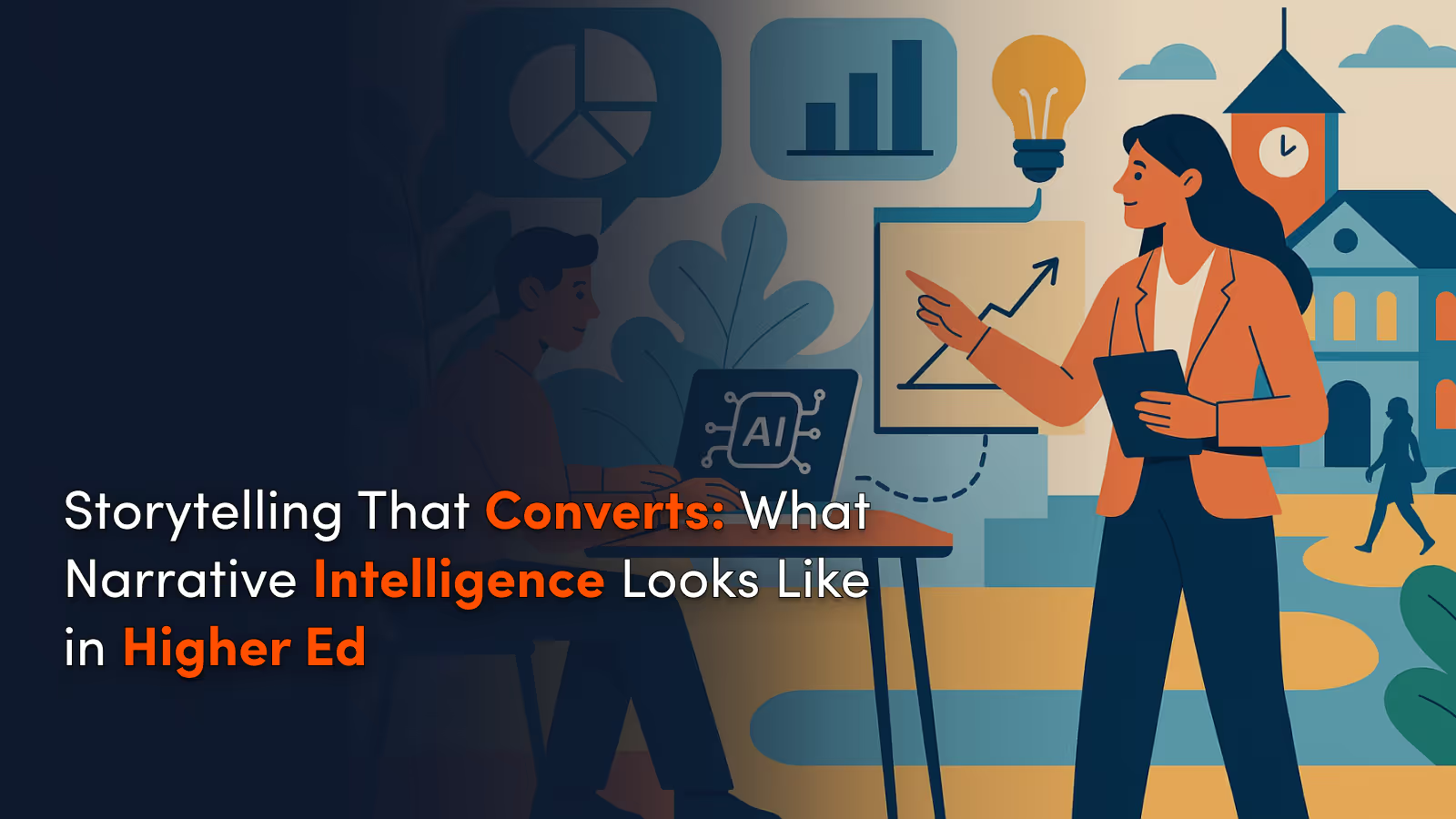About the Blog
If your audience is telling you what they care about in real time… why are you still guessing?
That’s the central question at the heart of a recent bonus episode of Pulse recorded live at the Engage Summit, where Erin Fields sat down with Safaniya Stevenson, a brand strategist, cultural analyst, and narrative detective. Their conversation was a deep dive into the emerging discipline of narrative intelligence and how tools like Pulsar’s Narrative AI can help higher ed teams see around corners, uncover deeper audience truths, and create content that resonates far beyond the admissions funnel.
This blog breaks down the key ideas from the episode into a practical guide—one that any communications, admissions, or advancement professional can use right now to build a smarter, more strategic marketing practice.
What Is Narrative Intelligence?
Safaniya puts it simply: narrative intelligence is the art and science of spotting the right story, not just telling one.
While AI tools can parse millions of social posts and online conversations, it still takes a strategist to ask the right questions, interpret the data, and craft meaning from it. In this context, tools like Pulsar’s Narrative AI are less about automation and more about augmentation—surfacing hidden trends, emotional undertones, and audience sentiments you may not otherwise detect.
In higher ed, this is especially valuable. Your prospective students (and their parents, peers, and counselors) are already telling you what matters to them, just not directly. They’re revealing their motivations, fears, and curiosities across social platforms, Reddit threads, YouTube comments, and TikTok trends. Narrative intelligence helps you translate that noise into actionable insight.
Admissions Example: Finding the Real Conversation
Say you're marketing an undergrad business program. You might assume students are focused on ROI, internships, and global exposure. But a narrative intelligence scan of student-led content might reveal a deeper emotional need: belonging in a competitive field without losing your sense of purpose. That’s a much richer—and more human—starting point for messaging.
Instead of running another “become a leader of tomorrow” campaign, your team could frame the program as a place where students build meaningful careers and learn how to lead with values. Narrative intelligence doesn’t just sharpen your messaging—it rewires the way you empathize with your audience.
Advancement Example: Reframing Alumni Engagement
The same approach applies in advancement. Maybe alumni aren’t engaging with your annual fund drive because they don’t see themselves in the narrative. A surface-level look might say, “Alumni are fatigued by donation requests.” But a narrative scan might show that they crave transparency, impact, and community.
So you shift. Instead of a campaign focused on institutional need, you spotlight micro-stories of impact, give donors access to real-time results, and connect them with the causes they care most about. Again: stop guessing, start listening.
What Higher Ed Can Learn from the Savannah Bananas
One of the most memorable case studies in the episode is a minor league baseball team: the Savannah Bananas. They’ve sold out Bank of America Stadium twice. But here’s the kicker: online, no one’s really talking about the baseball.
Using Pulsar’s AI, Safaniya and her team uncovered a surprising pattern—audiences were referring to Bananas games as shows, not games. They weren’t drawn to athletic competition; they were craving experience, performance, spectacle.
So what did the Bananas do? They leaned in. They rebranded themselves as an entertainment company, not just a baseball team. And in doing so, they unlocked a whole new audience.
The higher ed parallel? Institutions often market what they think they’re offering—degrees, majors, rankings—when students are actually searching for meaning, community, and momentum. When you understand your audience’s narrative, you can reposition your offering to meet them in the story they’re already telling.
How to Use Narrative Intelligence in Your Strategy
Here’s a simple framework—based on Safy’s recommendations—for integrating narrative intelligence into your marketing workflow:
1. Spot Category Spillover
Ask: Does this trend allow us to overlap with a cultural moment or industry we’re not traditionally part of?
Example: A STEM program joining conversations around climate justice instead of just engineering.
2. Stay True to Voice
Trend-jumping is only effective if it feels authentic to your brand.
Example: Don’t launch a viral TikTok series if your past tone has been buttoned-up and formal. Bridge with intention.
3. Audit Your Calendar
Scheduled content isn’t sacred. Trends and world events evolve fast.
Example: What felt clever last month could feel tone-deaf today. Regularly review and refresh.
4. Validate with Data, Lead with Curiosity
Use tools like Pulsar to understand what your audience actually cares about—then build from there.
Why This Matters Now
Narrative intelligence isn’t about being reactive. It’s about being in tune. As Safaniya says in the episode, today’s marketing isn't just about attention—it's about alignment. In a noisy world, the institutions that win are those who understand not only what their audience wants, but why.
So whether you're shaping a recruitment campaign, planning Giving Day messaging, or reevaluating your brand’s tone of voice, don’t just tell a better story. Find the right one.










